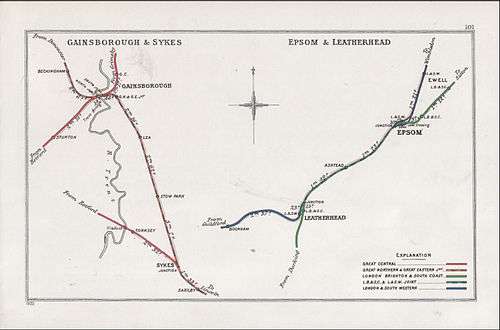Epsom and Leatherhead Railway
The Epsom and Leatherhead Railway (ELR) was an early independent railway company in southern England. It was jointly operated by the London and South Western Railway (LSWR) and London, Brighton and South Coast Railway (LBSCR). It is a key section of the route that later became known as the Portsmouth Line.
History
The LBSCR had served Epsom since 1847, from West Croydon via Sutton and Cheam (the Croydon and Epsom Railway), with ambitions to extend further west. But the LSWR wanted a share of the lucrative race traffic,[1] and to this end it supported a proposed Wimbledon and Dorking Railway (WDR), connecting the named towns via Epsom. Before that scheme could be approved, in 1857 the ELR was incorporated, pre-empting the central part of the WDR route.[2][3] The ELR opened on 1 February 1859, initially consisting of an isolated single-track line from Epsom to Leatherhead with an intermediate station at Ashtead.[4]

When the truncated WDR opened on 4 April 1859 it connected end-on to the ELR at their Epsom station. Later in 1859 the LBSCR connected to the ELR by extending from their existing Epsom terminus, which was renamed "Epsom Town".[4] Although the junction was at the ELR station the LBSCR did not have access to the platforms, which were used exclusively by LSWR services. A year after opening the ELR was acquired by the LSWR but operated by a Joint Committee of the LSWR and LBSCR. In 1863 the company was vested jointly in the LSWR and LBSCR by Act of Parliament.[5] They shared the stations at Ashtead and Leatherhead, but maintained separate stations at Epsom[6] until they were both absorbed into the Southern Railway at the Grouping.
The Dorking route was eventually completed in 1867 by the LBSCR-promoted Horsham, Dorking and Leatherhead Railway, continuing to Horsham on the Mid-Sussex Line. The LBSCR built its own Leatherhead station, leaving the original ELR station as a terminus for LSWR services.[7] The LSWR Leatherhead station was later connected to the New Guildford Line via the Bookham branch, becoming a through station on the route to Effingham Junction.[8] As at Epsom, both stations continued in use until the Grouping.
Services
From 1867 the ELR was a key section of the route from Victoria and London Bridge to the West Coastway line, with fast services to Littlehampton, Bognor Regis, Chichester and Portsmouth. After 1978 these were diverted via Three Bridges to serve Gatwick Airport.
There are now four principal outer suburban services:
- Waterloo to Guildford via Epsom
- Waterloo to Dorking
- Victoria to Dorking
- Victoria to Horsham via Epsom
References
- Dendy Marshall, C. F. (1963). History of The Southern Railway. 1 (2nd ed.). Ian Allen. p. 102.
- Turner, John Howard (1978). The London, Brighton & South Coast Railway. 2. Batsford. p. 72.
- White, H. P. (1982). Southern England. A Regional History of The Railways of Great Britain. 2 (4th ed.). Newton Abbot: David & Charles. p. 104.
- Turner, John Howard (1978). The London, Brighton & South Coast Railway. 2. Batsford. p. 73.
- Turner, John Howard (1978). The London, Brighton & South Coast Railway. 2. Batsford. p. 242.
- Dendy Marshall, C. F. (1963). History of The Southern Railway. 1 (2nd ed.). Ian Allen. p. 213.
- Dendy Marshall, C. F. (1963). History of The Southern Railway. 1 (2nd ed.). Ian Allen. p. 109.
- White, H. P. (1982). Southern England. A Regional History of The Railways of Great Britain. 2 (4th ed.). Newton Abbot: David & Charles. p. 127.